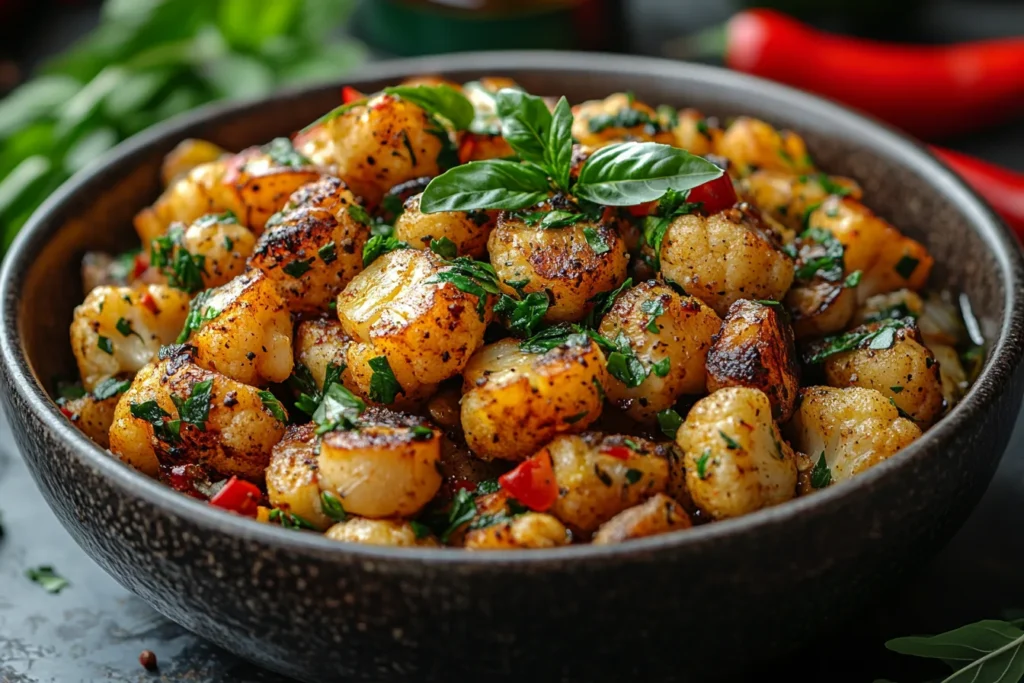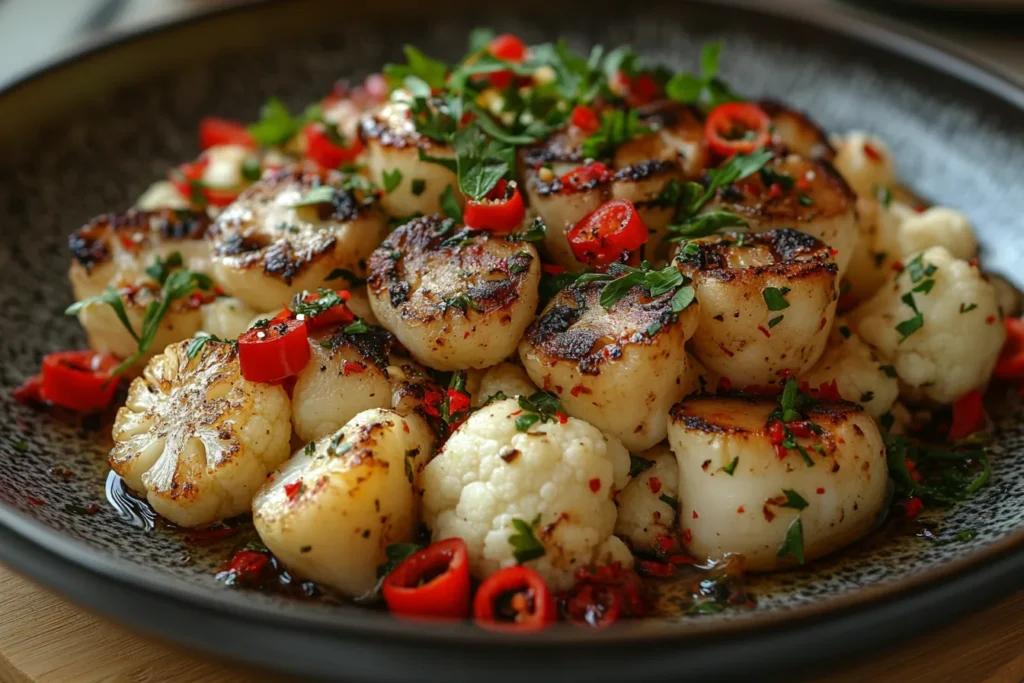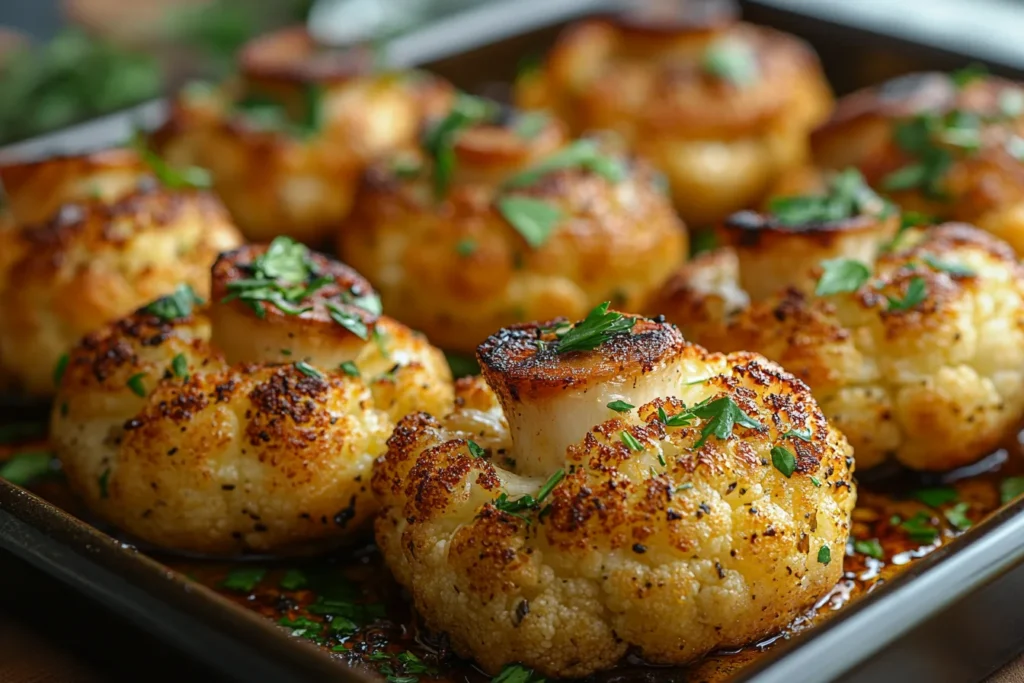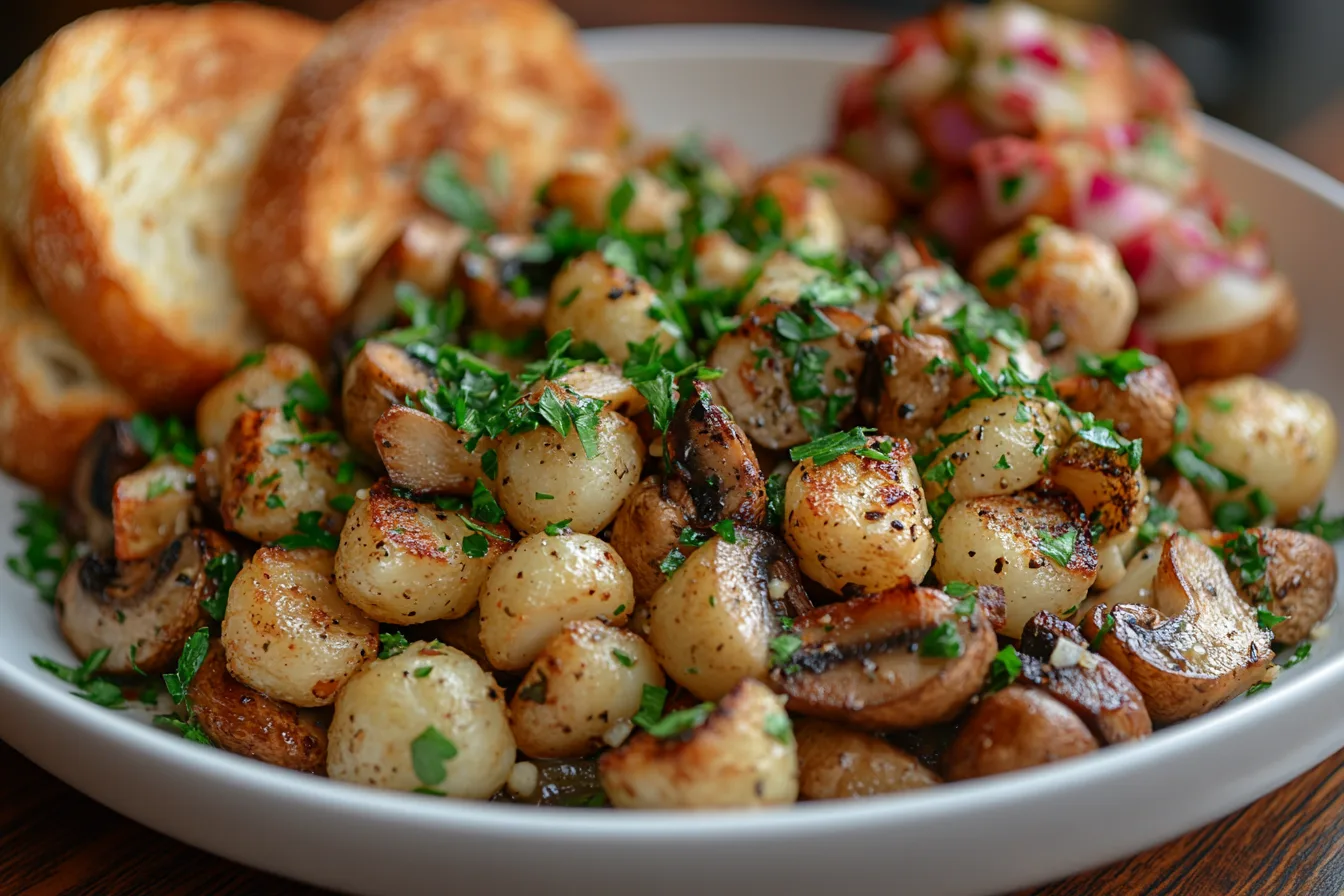Cauliflower mushrooms are a fascinating ingredient that can transform your culinary creations. Known for their unique texture and mild flavor, they offer endless possibilities in the kitchen. Whether you’re a seasoned cook or a curious beginner, this article will guide you through everything you need to know about cauliflower mushrooms, from their origins to preparing the perfect cauliflower mushroom recipe. If you’re interested in exploring other creative recipes, check out our Japanese Apple Pastry Recipes. Wondering how to prepare this mushroom properly? Learn more in How Do You Clean a Cauliflower Mushroom?. Let’s dive in!

Table of Contents
Origins and Unique Characteristics
The cauliflower mushroom, additionally known as Sparassis crispa, is a wild fungus that resembles a blooming coral or the top of a cauliflower. Its complicated folds and layers make it a standout aspect, both visually and texturally.
This mushroom is native to regions across North America, Europe, and Asia, generally determined near the base of conifer bushes. Its sponge-like look may seem delicate, however it holds up beautifully in a whole lot of recipes, making it a versatile option for soups, sautés, and stir-fries.
What actually sets this mushroom apart is its diffused nutty flavor and gentle, chewy texture. When cooked, it absorbs the flavors of other substances, developing an impossible to resist intensity to your cauliflower mushroom recipe. Its rarity and hanging appearance additionally make it a prized find among foragers.
Seasonality and Availability
If you’re hoping to make a fresh cauliflower mushroom recipe, timing is everything. These mushrooms are typically available during the late summer and early fall, depending on your location. Foragers often spot them in wooded areas, thriving near the roots of pine and spruce trees.
While foraging is an option, not everyone has access to a nearby forest. Luckily, cauliflower mushrooms are increasingly available at specialty markets and through online retailers. Look for clean, cream-colored specimens with no signs of decay to ensure the freshest flavor.
For year-round use, dried cauliflower mushrooms are a fantastic alternative. These retain the mushroom’s distinct taste and texture and can easily be rehydrated for your favorite recipes. Just soak them in warm water for about 30 minutes before adding them to your dish.
Nutritional Insights
Adding cauliflower mushrooms to your meals isn’t just about flavor it’s also a smart nutritional choice. These mushrooms are low in calories and fat while packing in a host of health benefits.
Here’s what makes them a healthy addition to your diet:
Rich in fiber: Cauliflower mushrooms support healthy digestion and keep you feeling full longer.
High in antioxidants: These help combat oxidative stress and support overall well-being.
Good source of vitamins: They’re especially high in vitamins D and B, which are essential for bone health and energy production.
Boosts immunity: The polysaccharides in cauliflower mushrooms are believed to support immune function.
By including these mushrooms in your cauliflower mushroom recipe, you’re not just creating a delicious meal but also a nutritious one that contributes to your health.
Preparing the Cauliflower Mushroom
Proper education is prime to bringing out the first-rate on your cauliflower mushroom recipe. Unlike greater commonplace mushrooms, the cauliflower mushroom calls for a piece of greater care due to its problematic folds.
Step 1: Cleaning the Mushroom
The first step is to thoroughly clean the mushroom to do away with dust and debris trapped in its layers. Follow those steps:
Gently shake the mushroom to dislodge loose debris.
Submerge it in a bowl of bloodless water and swirl gently. Repeat as wanted.
Use a soft brush or your fingers to easy stubborn areas.
Pat dry with a smooth towel earlier than use.
Step 2: Preparing for Cooking
Once wiped clean, the mushroom may be reduce into smaller portions or left whole, relying to your recipe. Its gentle texture means it cooks distinctly quickly, making it perfect for a huge variety of dishes.
Step 3: Cooking Techniques
Here are a few famous ways to cook cauliflower mushrooms:
Sautéing: A simple sauté with garlic, butter, and herbs highlights the mushroom’s herbal flavor.
Simmering: Add it to soups or stews for a hearty, chewy detail.
Basic Cooking Methods
Cauliflower mushrooms are versatile and easy to prepare, adapting beautifully to various cooking methods. Here are the most popular ways to cook them, each bringing out unique flavors and textures for your cauliflower mushroom recipe.
- Sautéing
Sautéing is quick and simple, perfect for preserving the mushroom’s chewy texture. Heat olive oil or butter in a skillet over medium heat. Add sliced mushrooms and cook for 5–7 minutes, stirring occasionally, until golden. Toss in garlic, salt, and fresh herbs for extra flavor. - Roasting
Roasting enhances the mushroom’s natural nuttiness and creates crispy edges. Preheat your oven to 400°F. Spread mushrooms on a baking sheet, drizzle with olive oil, and season with salt and spices. Roast for 15–20 minutes, flipping halfway through. - Stir-Frying
For bold flavors, stir-frying is the way to go. Heat oil in a wok over high heat, add mushrooms and vegetables, and cook for 5–6 minutes. Toss with soy sauce or stir-fry sauce, then serve over rice or noodles. - Simmering
Simmering is ideal for soups and stews. Add mushrooms to boiling broth during the last 10–15 minutes of cooking to infuse their mild, earthy flavor into the dish. - Deep-Frying
Deep-frying creates a crispy treat. Dip mushrooms in batter, fry at 350°F for 2–3 minutes, and serve with dipping sauce for a crowd-pleasing snack. - Steaming
For a light option, steam mushrooms for 5–7 minutes over boiling water. Season with lemon juice or soy sauce for a simple yet delicious side.
Enhancing Flavor Profiles in Cauliflower Mushroom Recipes
Cauliflower mushrooms are delicious on their own, but the right flavors can turn a good dish into an unforgettable one. Their mild, nutty taste and sponge-like texture make them perfect for soaking up bold seasonings. Let’s break down some ways to bring out the best in your cauliflower mushroom recipe.
- Aromatics
Aromatics like garlic, onion, and shallots are the foundation of flavor. Sautéing these in butter or olive oil before adding mushrooms creates a rich, savory base. For an extra kick, try ginger or lemongrass—especially for Asian-inspired dishes. - Herbs and Spices
Fresh herbs like thyme, parsley, and rosemary pair beautifully with cauliflower mushrooms. If you’re feeling adventurous, dried spices like smoked paprika, turmeric, or cumin can add warmth and depth. For a hint of heat, consider chili flakes or cayenne. - Acidity
A splash of acidity brightens any dish. Add a squeeze of lemon, a drizzle of balsamic vinegar, or a spoonful of white wine to balance the mushroom’s richness. - Umami Boosters
Cauliflower mushrooms already have a subtle umami taste, but ingredients like soy sauce, miso, or nutritional yeast can amplify it. A touch of parmesan or a sprinkle of truffle salt also works wonders. - Texture Contrast
For textural variety, pair the mushrooms with crunchy toppings like toasted breadcrumbs, nuts, or seeds. This contrast adds another layer of enjoyment to your cauliflower mushroom recipe.

Recommended Tools and Equipment
To prepare the perfect cauliflower mushroom recipe, having the right tools on hand makes all the difference. Their intricate texture and unique cooking needs require specific equipment to clean, prep, and cook them effectively. Here’s what you’ll need:
- Soft Brush or Kitchen Tweezers
Cauliflower mushrooms have lots of folds that trap dirt and debris. A soft brush helps gently clean the mushroom without damaging its delicate texture. Tweezers are great for removing stubborn particles from the crevices. - Sharp Knife
A high-quality chef’s knife is essential for slicing cauliflower mushrooms into manageable pieces. Their spongy texture requires a sharp blade for clean, precise cuts. A paring knife can also help for trimming finer details. - Cutting Board
A sturdy cutting board gives you a stable surface for preparing the mushrooms. Choose a large board to accommodate their size and prevent clutter while you work. - Large Bowl
Use a large bowl filled with cold water to rinse the mushrooms thoroughly. Swirling them gently in water helps dislodge dirt from their intricate folds. - Skillet or Sauté Pan
A nonstick or stainless-steel skillet is perfect for sautéing cauliflower mushrooms. Opt for a pan with even heat distribution to ensure the mushrooms cook evenly. - Baking Sheet
If roasting is your chosen method, a quality baking sheet is key. A rimmed sheet works best to prevent oil or juices from spilling during cooking. - Wok or Stir-Fry Pan
For stir-frying, a wok offers high sides and even heat, allowing you to cook the mushrooms quickly and retain their texture. - Steamer Basket
If you plan to steam the mushrooms, a steamer basket is a must. It allows even cooking while preserving the mushroom’s tender texture.
Classic Cauliflower Mushroom Recipes
Cauliflower mushrooms are versatile and easy to cook, making them perfect for various classic dishes. Here are a few must-try cauliflower mushroom recipes to inspire your next meal.
- Sautéed Cauliflower Mushrooms with Garlic and Herbs
Sauté the mushrooms in olive oil or butter with minced garlic and fresh herbs like thyme or parsley. Cook for 5–7 minutes until golden. This simple dish works as a side or topping for toast. - Roasted Cauliflower Mushrooms
Toss mushrooms with olive oil, balsamic vinegar, smoked paprika, salt, and pepper. Roast at 400°F for 15–20 minutes until crispy. Pair with salads or serve as a snack. - Creamy Cauliflower Mushroom Soup
Simmer mushrooms, onions, garlic, and broth for 15 minutes. Blend until smooth, add cream, and season with salt and pepper. It’s rich, comforting, and perfect for cold days. - Stir-Fried Mushrooms with Vegetables
Cook mushrooms with bell peppers, carrots, soy sauce, and sesame oil over high heat. Serve over rice or noodles for a quick, flavorful meal. - Deep-Fried Cauliflower Mushroom Bites
Dip mushroom pieces in seasoned batter and fry until golden. Serve with your favorite dipping sauce for a crispy treat.
Vegan and Vegetarian Adaptations
Cauliflower mushrooms are naturally vegan and vegetarian-friendly, making them an ideal ingredient for plant-based dishes. Their chewy texture and mild, nutty flavor mimic meat in many recipes, making them a versatile addition to vegan and vegetarian menus. Here are some ways to adapt cauliflower mushroom recipes for plant-based cooking.
- Vegan Cauliflower Mushroom Soup
Swap out the cream in traditional recipes for plant-based alternatives. Coconut milk, cashew cream, or oat milk adds creaminess without dairy. For extra flavor, blend roasted garlic or nutritional yeast into the soup base. - Meat-Free Stir-Fry
Replace traditional protein sources like chicken or beef with cauliflower mushrooms. Stir-fry them with vegetables like bell peppers, snap peas, and carrots in a mix of soy sauce, ginger, and sesame oil. Serve over brown rice or quinoa for a wholesome meal. - Vegan Mushroom Bites
For deep-fried or breaded mushroom bites, use a batter made from chickpea flour and water instead of eggs. Pair with a vegan dipping sauce like sriracha mayo (made with vegan mayo) or tahini dressing. - Roasted Mushroom Bowl
Roast cauliflower mushrooms with olive oil, smoked paprika, and garlic powder. Serve over a bed of greens, roasted sweet potatoes, and quinoa, topped with tahini or avocado dressing. - Vegan Mushroom Pasta
Create a creamy pasta sauce using blended cashews, garlic, and nutritional yeast. Toss with roasted cauliflower mushrooms and whole-grain pasta for a filling, dairy-free meal.
Gourmet Presentation and Plating
Elevating your cauliflower mushroom recipe into a gourmet experience starts with thoughtful plating and presentation. With their unique texture and striking appearance, cauliflower mushrooms naturally lend themselves to artistic arrangements. Here’s how to plate them like a pro for an unforgettable dining experience.
- Focus on the Mushroom as the Star
Highlight the cauliflower mushroom by placing it at the center of the plate. For sautéed or roasted dishes, arrange the mushrooms in layers or clusters to emphasize their natural, coral-like structure. Keep garnishes minimal to let the mushrooms stand out. - Use Complementary Colors
Contrast the cream color of the mushrooms with vibrant sides. For example:
Pair with roasted beets or sweet potatoes for bold reds and oranges.
Add a drizzle of green herb oil or garnish with fresh parsley for a pop of color.
- Texture is Key
Create visual interest by combining textures:
Serve crispy, deep-fried mushroom bites alongside smooth purees.
Add crunch with toasted nuts or seeds as a garnish.
- Plate with Height
Stack or layer elements of the dish to add dimension. For example, place mushrooms over a bed of creamy polenta or a dollop of garlic-infused mashed potatoes. - Add Finishing Touches
Use small, thoughtful accents like microgreens, edible flowers, or a drizzle of balsamic reduction to complete the plate. A sprinkle of flaky sea salt adds a touch of sophistication.
Common Pitfalls and Troubleshooting
Cooking cauliflower mushrooms can be straightforward, but a few missteps can compromise their flavor and texture. To ensure your cauliflower mushroom recipe turns out perfectly every time, here are some common pitfalls to avoid and tips for troubleshooting.
- Inadequate Cleaning
Pitfall: Cauliflower mushrooms have intricate folds that often trap dirt and debris. Skipping a thorough cleaning can result in gritty, unpleasant bites.
Solution: Submerge the mushrooms in cold water, swirl gently, and repeat as needed. Use a soft brush or tweezers to clean stubborn areas. Always dry them thoroughly before cooking to prevent excess moisture. - Overcooking
Pitfall: Cooking cauliflower mushrooms too long can make them mushy and overpower their delicate flavor.
Solution: Keep cooking times short, especially for sautéing or stir-frying (5–7 minutes is usually enough). For roasting, monitor them closely and remove them as soon as they’re golden and tender. - Underseasoning
Pitfall: The mushroom’s mild flavor can feel bland without proper seasoning.
Solution: Season generously with salt, pepper, and complementary spices or herbs. Cauliflower mushrooms also absorb sauces well, so don’t shy away from bold flavors like soy sauce, garlic, or balsamic glaze. - Using the Wrong Cooking Method
Pitfall: Certain methods, like boiling, can make cauliflower mushrooms lose their texture and flavor.
Solution: Stick to sautéing, roasting, stir-frying, or steaming, which preserve their chewy texture and enhance their natural nuttiness. - Not Adjusting for Freshness
Pitfall: Using old or wilted mushrooms can result in an unpleasant taste and texture.
Solution: Choose fresh mushrooms with a firm texture and a light cream color. If using dried mushrooms, ensure they’re fully rehydrated in warm water before cooking. - Overcrowding the Pan
Pitfall: Cooking too many mushrooms at once causes them to steam rather than brown.
Solution: Cook in batches to allow even browning and to develop their nutty flavor.

Frequently Asked Questions
How do I clean cauliflower mushrooms?
Submerge them in cold water and gently swirl to remove dirt. Use a soft brush or tweezers for stubborn debris. Repeat if needed and pat dry before cooking.
Can I use dried cauliflower mushrooms?
Yes! Rehydrate them in warm water for 30 minutes, then drain and use as you would fresh mushrooms. They retain their texture and absorb flavors well.
What’s the best way to store fresh cauliflower mushrooms?
Wrap them in a paper towel and store in a breathable container in the fridge. Use within 3–5 days for optimal freshness.
Conclusion and Final Thoughts
Cauliflower mushrooms are a unique and flexible component which can increase your cooking with their texture, flavor, and adaptableness. Whether you’re sautéing them for a quick aspect dish, roasting them for a ambitious entrée, or incorporating them into soups and stir-fries, they shine in a number of recipes.
From their nutritional advantages to their capability to supplement plant-primarily based and gourmet dishes, cauliflower mushrooms deserve a niche on your kitchen. By avoiding not unusual pitfalls, the use of the proper equipment, and experimenting with specific cooking strategies, you’ll unlock their full potential in each cauliflower mushroom recipe.

